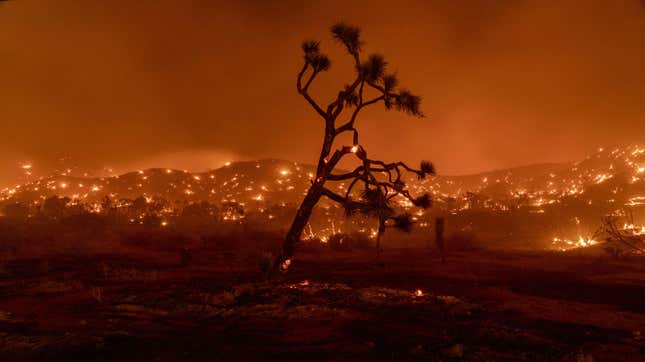
Western Joshua trees, those strange-looking, tall beauties of Southern California, are the first-ever plant species to be protected under the California Endangered Species Act because of the threat of climate change.
In a historic move this week, the state’s Fish and Game Commission voted unanimously in favor of a petition that provides the plants protected status for a year while the state conducts a study on the dangers they face. After conducting that research, the commissioners will decide whether or not those protections should be made permanent.
The petition the commissioners approved was submitted by the Center for Biological Diversity last year due to increasing concern about the spiky-leafed, gnarly-limbed plants’ future. Rising temperatures, worsening drought, and a loss of groundwater have all put the trees in crisis. The commission previously put off the vote twice in the face of an overwhelming amount of public comments—both for protecting the tree from conservationists, and against the move from developers.
“This is a huge victory for these beautiful trees and their fragile desert ecosystem,” Brendan Cummings, the Center for Biological Diversity’s conservation director who lives in the town named after the plant, said in a statement. “If Joshua trees are to survive the inhospitable climate we’re giving them, the first and most important thing we can do is protect their habitat. This decision will do that across most of their range.”
Recent research found that if global greenhouse gas emissions continue at their current rate, just 0.02% of the plants’ current habitat in Joshua Tree National Park will remain viable for their survival. Even with drastic global climate measures, only 18.6% of the trees’ original habitat would remain.
The damage has already begun. In August, the massive Dome fire scorched 43,000 acres of Mojave National Park, burning 1.3 million of the otherworldly plants to a crisp.
The temporary measure approved this week will provide Joshua trees with some protections from development. If the plants win permanent protection under California’s Endangered Species Act, state and local agencies will have to manage threats to them by developing a recovery plan outlining a strategy to protect the species from climate-related threats and development.
Joshua trees have grown in the Mojave Desert for some 2.5 million years. Though they’re referred to as trees, they are actually succulent plants. There are two versions of the plant, but this move would specifically protect the western variety.
Though the vote was a victory for conservationists, it was also a bit of a mixed bag. The state commission approved an emergency exemption allowing the removal of Joshua trees at the sites of 15 solar energy projects slated for Kern and San Bernardino counties. However, the developers will be required to put money into a mitigation fund used to preserve Joshua trees in their other habitats.
“This summer’s raging wildfires, heatwaves and hurricanes confirm our dire climate crisis and the need to urgently achieve 100% renewable energy,” Cummings said. “But the best places to put solar panels are on rooftops, parking lots and degraded farmland, not pristine desert habitats. We disagree that these exemptions are needed, but we understand the commission’s decision.”